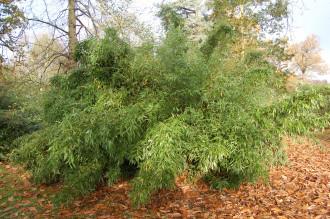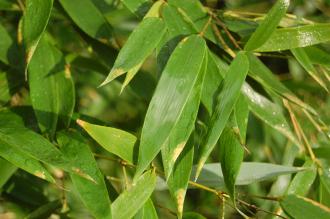
Phyllostachys bissetii (30/11/14, Kew Gardens, London)
Position: Sun to light shade
Flowering Period: N/A
Soil: Moist, well drained
Eventual Height: 5m
Eventual Spread: 3m
Hardiness: 6a, 6b, 7a, 7b, 8a, 8b, 9a, 9b
Family: Poaceae
Phyllostachys bissetii is a fast growing, evergreen, clump forming bamboo with an arching habit. Its mid green leaves are linear with entire margins and are up to 11cm long and 16mm broad. Its green culms fade to yellow/ green and are are up to 2cm in diameter. Its culm sheaths are brown in color. This plant produces underground rhizomes which aids its spread.
Phyllostachys bissetii, commonly known as Bisset’s Bamboo, is native to China. In its native habitat it grows in monotypic stands of bamboo forest.
The etymological root of the binomial name Phyllostachys is derived from the Greek phyllon meaning ‘leaf’ and stachys meaning ‘spike’. Bissetii is named after David Andreas Bisset (1892–?), a United States Garden’s Superintendent.
The landscape architect may find Phyllostachys bissetii useful as a useful as a screening hedging plant that is low maintenance. Caution must be exercised when specifying this plant due to its potentially invasive nature. A root barrier may be used to contain its spread.
Ecologically, Phyllostachys bissetii is of little wildlife value in the UK.
The Royal Horticultural Society has given Phyllostachys bissetii their prestigious Award of Garden Merit in 2012.

Phyllostachys bissetii Leaf (30/11/14, Kew Gardens, London)
Phyllostachys bissetii prefers moist, humus rich, well-drained soils. It tolerates most pH of soil.
Phyllostachys bissetii requires little to no maintenance. A root barrier may be installed at the time of planting to restrict the spread of this plant. The plant may be thinned out of required and spent canes may be cut back to the ground level.

